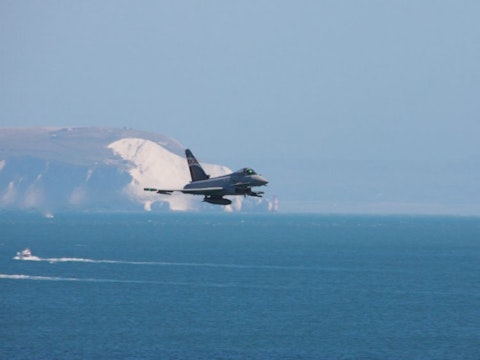Corporación América Airports S.A. (NYSE:CAAP) Q4 2022 Earnings Call Transcript March 22, 2023
Operator: Good morning, and welcome to the Corporación América Airports’ Fourth Quarter 2022 Earnings Conference Call. A slide presentation accompanies today’s webcast, and is available in the Investors section of the Corporación América Airports’ Web site. As a reminder, all participants will be in listen-only mode. There will be an opportunity to ask questions at the end of the presentation. At this time, I would like to turn the call over to Patricio Inaki Esnaola, Head of Investor Relations. Patricio, please go ahead.
Patricio Esnaola: Thank you. Good morning, everyone, and thank you for joining us today. Speaking during today’s call will be Martin Eurnekian, our Chief Executive Officer; and Jorge Arruda, our Chief Financial Officer. Before we proceed, I would like to make the following Safe Harbor statement. Today’s call will contain forward-looking statements and I refer you to the forward-looking statements section of our earnings release and recent filings with the SEC. We assume no obligation to update or revise any forward-looking statements to reflect new or changed events or circumstances. Now, let me turn the call over to our CEO, Martin Eurnekian.
Martin Eurnekian: Thank you, Inaki. Hello, everyone, and welcome to our fourth quarter and full-year 2022 earnings call. First, I will provide a quick summary of our financial highlights presented on slide three, and then provide a brief update on the industry trends and cargo activity. I will then hand the call over to Jorge to discuss the fourth quarter and annual financial results. To begin, we are pleased to have ended the year with a strong quarter, delivering sustained and continued growth in revenues and adjusted EBITDA. These results underscore the recovering demand for air travel globally and the good performance of our countries of operation in particular. Total revenues excluding IFRIC were up 10.6% against fourth quarter of 2019, supported by a strong growth in commercial revenues and continued recovery in passenger traffic.
This, along with our ongoing focus on cost control allowed us to report an adjusted EBITDA of $123 million in the quarter, increasing 27% against the comparable period in the fourth quarter of 2019, while passenger traffic in 2022 stood at 88% of pre-pandemic levels. During the quarter, we obtained $13.6 million in economic re-equilibrium compensation in Brazil in connection with the impact of the COVID-19 pandemic during 2022. This compensation was utilized as a credit towards the payment of the fixed concession fee, due 2022, and follows the economic re-equilibrium compensation of $25.5 million and $32.2 million received in 2021 and 2020, respectively. On full-year basis, we delivered revenues ex-IFRIC $1.2 billion, and an adjusted EBITDA of $457 million, most importantly, with positive contributions from all countries of operations.
We ended the year with a healthy balance sheet with our net debt to adjusted EBITDA further improving to 2.4 times, down from 7.1 times at the end of December, 2021, driven by the significant recovery in adjusted EBITDA, while we were able to maintain stable debt levels. This healthy position provides us with the flexibility to continue selectively expanding our airport portfolio. We are proud that in a recent passenger survey conducted by ACI World recognizing the best airports for customer experience worldwide, our Guayaquil International Airport, in Ecuador, was awarded the best airport within the two to five million passenger range. The airport with the most dedicated staff and the most enjoyable and cleanest airport in Latin America and the Caribbean.
This recognition is a testament to our commitment to providing exceptional service and ensuring a seamless travel experience for all travelers that pass through our airports. As shown on the left-chart on slide four, we are encouraged by the continued recovery in travel demand, with passenger traffic in the fourth quarter reaching 88% of fourth quarter of 2019 level, compared with the 82% in the third quarter. We are also seeing this trend continue in the first two months of the year, reaching nearly 90% of pre-pandemic levels. Overall, a total of 66 million passengers traveled across our airports during the year, reaching 78% of 2019 levels, and up to (ph) year-on-year. Let’s go briefly on a country-by-country basis. Armenia; we continue to deliver a strong performance.

Photo by Jonathan Ridley on Unsplash
Entrance of new airlines and increased flight frequencies contributed to the third consecutive quarter beating pre-pandemic traffic levels, and leading to the recovery with passenger traffic, up 37% above fourth quarter of 2019. This rebound continued into February, when traffic was up 91% versus February, 2019. In Ecuador, passenger traffic was nearly at pre-pandemic levels, supported by a higher number of flight frequencies in both domestic and international travel. Strong traffic with the U.S., Europe, and Panama continues to support international performance which continued into February, when traffic was up 1% compared to February, 2019. Argentina continued the pace to full recovery at slightly over 92% of pre-pandemic levels, from 80% in the prior quarter.
This was driven by a good performance in most domestic and international traffic. Domestic traffic, which accounts for 70% of the total traffic, has almost fully recovered, reaching nearly 98% of pre-COVID levels, while international traffic improved to 82% of fourth quarter of 2019 traffic. In Uruguay, passenger traffic, which is mainly international, also continued to recovery, reaching 83% of fourth quarter of 2019 levels, up from 68% in the prior quarter. Traffic in Italy reached 86% of pre-pandemic levels compared to the prior quarter, which benefited from the (ph) season. In February, traffic in Italy reached 90% of February, 2019 levels. Softer performance in Brazil reflects lower traffic from government officials during the change in Brazilian federal administration, compounded by higher airfares which impacted overall travel demand.
In February, traffic in Brazil reached 82% of February, 2019 levels. Moving on to slide five, during the fourth quarter, cargo activity reached nearly 81% of pre-pandemic levels, with notable contributions from several regions. Argentina, Brazil, Ecuador, and Uruguay were the main contributors to cargo activity, which together accounted for almost 85% of total volume in the quarter. In Argentina, cargo volumes have been suffering from a deteriorating macroeconomic environment as reflected by a lower level of imports, but contrast, cargo volume in Italy and Armenia exceeded pre-pandemic levels, indicating a strong recovery in those regions. Meanwhile, cargo volume in Uruguay and Ecuador were at 97% and 93% of pre-pandemic levels, respectively.
Overall, we are encouraged by this positive trend in the cargo industry, and remain committed to supporting our customers as we continue to navigate the ongoing macro challenges. I will now hand off to Jorge, who will review our financial results. Please, Jorge, go ahead.
Jorge Arruda: Thank you, Martin, and good day, everyone. Starting with our top line on slide six, total revenue ex-IFRIC continue to deliver strong growth, surpassing pre-pandemic levels by 11% in fourth quarter 2022, and by 2% for the full-year of 2022, reaching $1.2 billion. Aeronautical revenues increased 79% year-on-year, mainly driven by continued recovery in passenger traffic across geographies, reaching over 95% of fourth quarter 2019 levels. Armenia remains one of our key drivers of growth, with aeronautical revenues increasing double digits year-on-year, and also against fourth quarter, 2019. We are very pleased with the performance of Ecuador, and the strong recovery in Argentina mainly driven by domestic traffic growth.
Commercial revenues was up 44% year-on-year and 30% above pre-pandemic levels. We benefited from tariff adjustment in our cargo business, and the solid performance of parking and duty-free revenues in Argentina, and higher fuel-related revenues in Armenia. As a reflection of these strong results, our revenue per passenger increased by 26%, from $14.1 in the fourth quarter, 2019, to $17.8 this quarter. For the full-year of 2022, our revenue per passenger increased by 30%, reaching $18.7. Now turning to our cost structure on slide seven, total cost and expenses for the quarter increased 45% year-on-year ex-IFRIC reflecting the continued recovering business activity that steeply grew our revenue growth. Compared to 2019 and excluding the impairment charge recorded in the fourth quarter 2019, total cost on expenses ex-IFRIC for the quarter increased by 8%, which is mainly explained by higher fuel cost in Armenia due to the strong increase in fuel sales in the quarter and to a lesser extent by higher salaries in Argentina as the local inflation rate was significantly above currency depreciation.
Excluding fuel cost in Armenia, total cost in expense ex-IFRIC would have increased 0.6% against fourth quarter 2019. Now turning to profitability on slide eight, we delivered an adjusted EBITDA of $123 million in the quarter. Up 33% year-on-year and 27% when compared to fourth quarter 2019 with adjusted EBITDA margin reaching 37%. All geographies contributed to this good performance. For the full-year, adjusted EBITDA totaled $457 million from $149 million in 2021. Compared to pre-pandemic levels of 2019, adjusted EBITDA was up 7%. Note that for comparison purpose 2019 figures for the quarter and the year exclude impairment charges recorded in the Brazil in the fourth quarter 2019. Turning to Slide 9, we ended the year with a total liquidity position of $452 million, relatively stable compared to the year and 2021, despite the fact that during 2022 we fully redeemed the preferred shares in AA2000, which totaled to $174 million and accounted as a credit towards the $406 million CapEx program.
We also made significant progress in our CapEx programs in Argentina and Uruguay pursuing to the respective extension agreements. Moving on to our debt and maturity profile on slide 10, total debt at the end of the year was approximately $1.5 billion, while our net debt stood at $1.1 billion. We ended the year with a strong balance sheet and healthy debt profile with no significant maturities until 2024. Our net leverage ratio improved 2.4 times from 7.1 times in December 2021. We remain committed to maintaining a disciplined and balanced financial approach that will allow us to continue to (ph) future value from our stakeholders. I will now hand back the call to Martin who will discuss our view for the remaining of the year and provide closing remarks.
Martin Eurnekian: Thank you, Jorge. Now to wrap up, please turn to Slide 12. We are expecting passenger traffic to continue the recovery trend and may see the return of pre-pandemic levels in some additional countries of operations. We remain vigilant with macroeconomic forces pressuring consumer spending and the geopolitical environment is overwhelming. Nevertheless, given our healthy balance sheet we will continue to analyze investment opportunities to drive and sustain long-term growth. With respect to our concessions in Argentina and Uruguay, we are well on track. We have CapEx obligations pursuant to the extension agreements previously announced. We also have new infrastructure expansion projects underway in Armenia and Italy.
And, we are currently in discussions with the respective government officials. In Brazil, we recently entered into agreements to develop two new large scale real estate projects at the Brasilia airport adding to the three projects that were previously announced. Additionally on January 18, the Tribunal de Contas da União, a government entity, has given clearance for the government to carry out the tender process for the Natal airport. And the auction date has been set for May 19th this year. Subject to the successful completion of the new tender process, we expect to receive an indemnification payment in the fourth quarter of this year. As previously mentioned in October last year, we were appointed as the preferred bidders to operate Abuja and Kano airports in Nigeria.
And we are progressing in our discussions and negotiations with the Nigerian authorities to finalize the terms of the concession agreements. In conclusion, we are very proud of our recent achievements, passenger recovery and financial performance. I would also like to take this opportunity to thank all of our employees for their hard work during another challenging year. This ends our prepared remarks. We are ready to take your questions. Operator, please open the line for questions.
See also 15 Best Stocks Under $10 To Buy Now and 20 Popular Investor Websites for Dividend Paying Stocks.
Q&A Session
Follow Citizens Capital Corp (OTCMKTS:CAAP)
Follow Citizens Capital Corp (OTCMKTS:CAAP)
Operator: Thank you, Martin. We have a question from Stephen Trent from Citi. Please go ahead.
Stephen Trent: Good morning, gentlemen, and thanks very much for taking my question, just one or two for me. The first is if you could refresh my memory regarding what is the traffic flow impact in Armenia resulting from the war in Eastern Europe? Do you have a fair bit of traffic that’s diverted there, and versus what had been the case before the war started there? Thank you.
Jorge Arruda: Hi, Steve, it’s Jorge, here. How are you?
Stephen Trent: Hey, Jorge, I’m good. Thank you.
Jorge Arruda: Thanks again for your question. So, look, if I understood correctly your question, you’re seeing the significant increase in traffic, et cetera, that we are experience in Armenia. And the primary reason is traffic that otherwise, prior to the war, were flying directly into or out of Russia into Europe. And Armenia, from a geographical perspective, is one of the best locations for you to travel into Russia or out of Russia, connecting somewhere. It is true that there has been a lot of immigration into Armenia. And I think some of that is there to stay. But we have continued to see very strong demand for traffic in our Armenian airport.
Stephen Trent: Okay, appreciate it. Thanks, Jorge. And just one more for me, when I think about your potential expansion into new markets, you mentioned Nigeria, which I appreciate. And I recall you also had this agreement with an investment wing of the Government of UAE, if I believe. How should we think about, on a longer-term basis, what geographies you might be targeting as I’d — maybe the exact (ph) I just mentioned, perhaps adjusted your plans for investments in Easter Europe and the Middle East, would just love to get your color? Thank you
Jorge Arruda: Thank you, Steve. So, look, the pillars of our decision to go into Nigeria are, generally speaking, very conservative approach. Secondly, a marginal deployment of equity. Third, strong downside protection embedded in the concession agreement. And, overall, very conservative approach in terms of every possible aspect, like projections, et cetera. It’s obviously a large country, and truly undeveloped, that we see some growth opportunities, and hopefully creating a base for further growth in the region.
Stephen Trent: Okay, I appreciate it. Thank you very much.
Operator: We currently have no further questions. So, I’ll hand it back over to Martin Eurnekian.
Martin Eurnekian: I would like to thank everybody for your interest in our growing company, and joining us today. I wanted to remind you that our team remains available for everybody. So, I hope you have a good day ahead of you. Thank you very much.
Operator: This concludes today’s call. Thank you for joining. You may now disconnect your lines.




